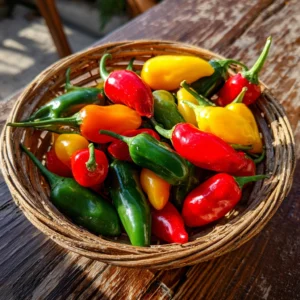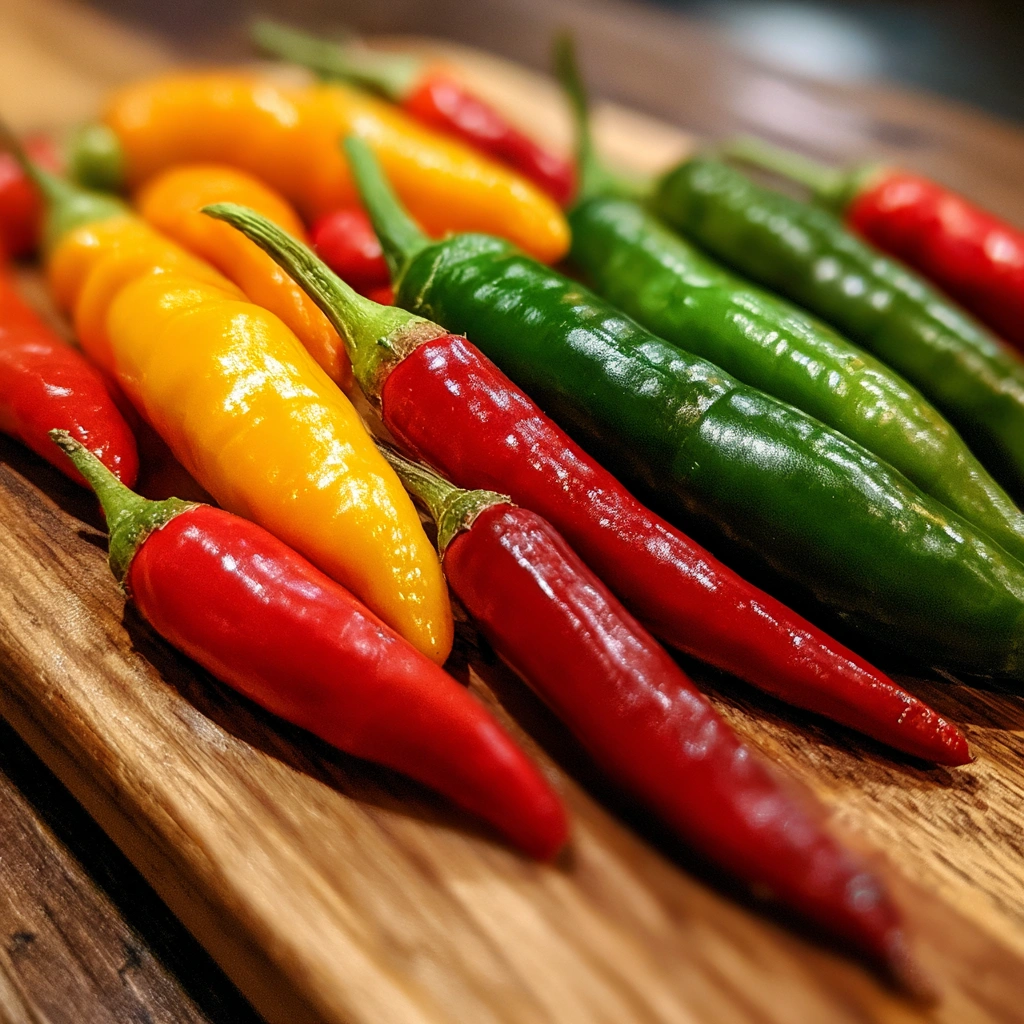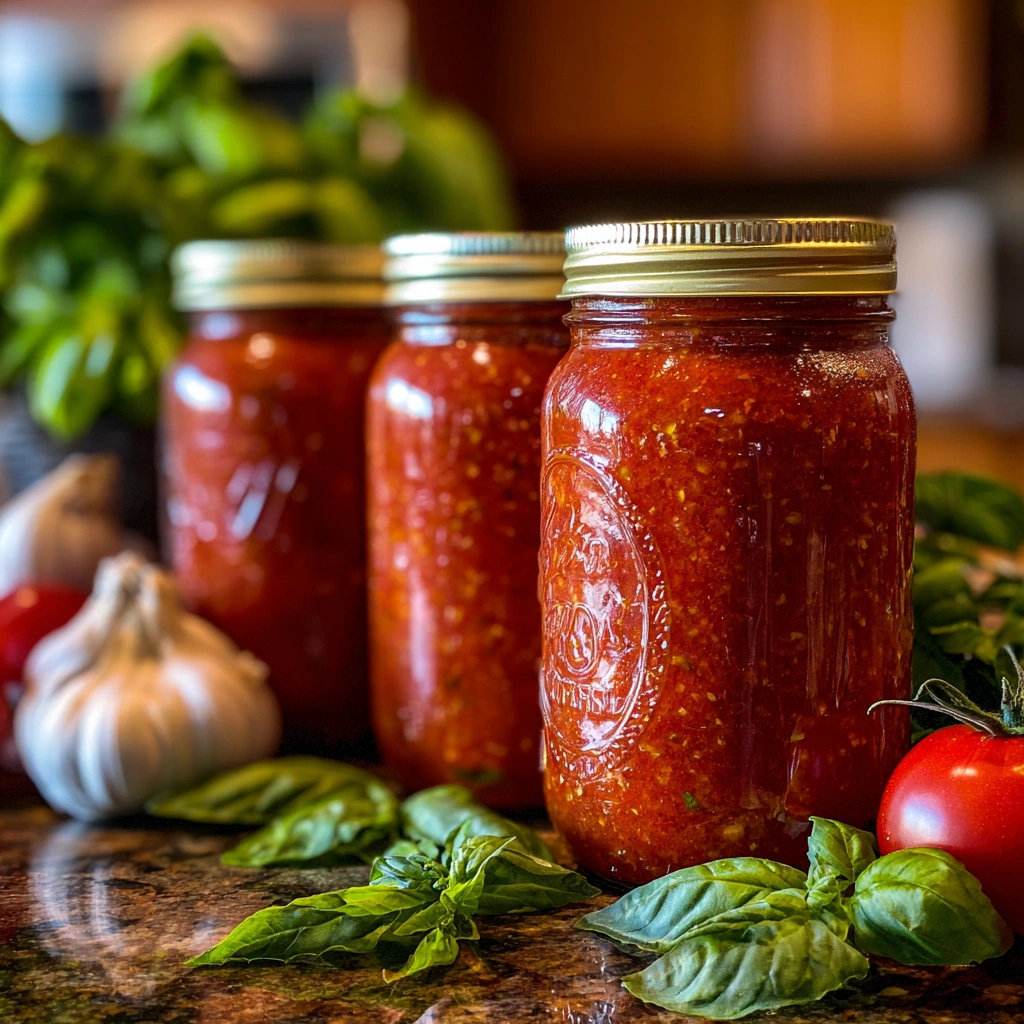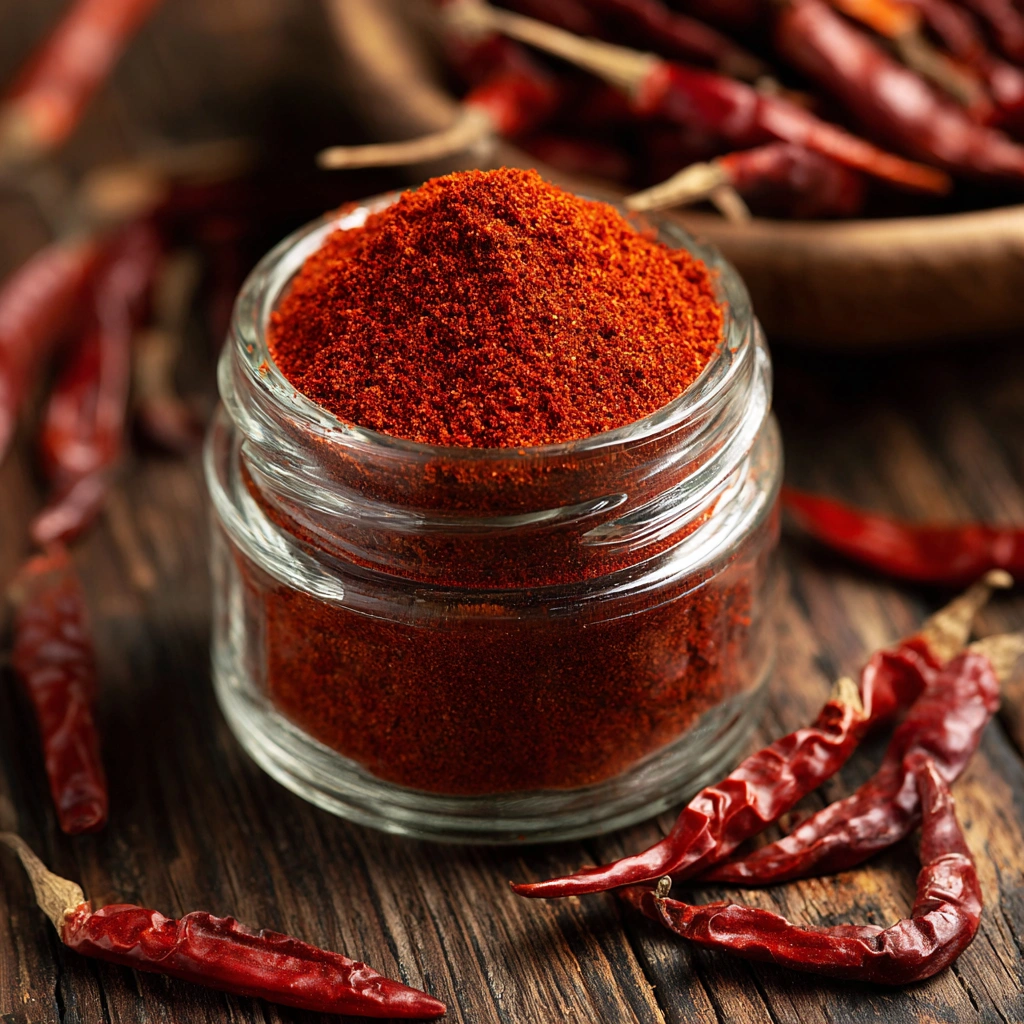Chili pepper has always been at the heart of my cooking. My passion for food was born in my family’s kitchen, surrounded by sizzling pans, vibrant spices, and the comforting smell of slow-cooked meals. I grew up learning how to make food that nourishes the soul and brings people together. Those early moments became the foundation for everything I do in the kitchen today.
Over the years, I trained professionally, cooked across different cultures, and gathered recipes, stories, and techniques that helped shape my unique style. But no matter where I’ve cooked — whether in restaurant kitchens or tiny home spaces — I always come back to one simple idea: food made with love is the best kind.
That’s why I created Chili Meal — a place to share easy, flavorful recipes that anyone can make, with a little passion and a pinch of spice. Every season, we plant a garden overflowing with tomatoes, herbs, and of course, chili peppers. There’s something deeply satisfying about harvesting fresh chili peppers and turning them into sauces that warm your winter or powders that spark up your meals.
In this article, I’ll guide you through everything you need to know about chili peppers — from growing them in your garden to preserving them for the cold months, creating quick spicy sauces, understanding their health benefits, and using their fiery magic in your everyday cooking. Learn more about our preserving methods in our chili pepper preserving section to discover great techniques you can try today.
Table of Contents

Chili Pepper
Ingredients
- 4 cups fresh tomatoes Roma or heirloom, chopped
- 4 cups fresh chili peppers bell, jalapeño, serrano, Thai – mix for desired heat, chopped
- 1 cup fresh basil leaves optional
- 4 cloves garlic peeled
- 1 teaspoon salt
Instructions
- Prep Ingredients: Wash and chop tomatoes and peppers. Remove seeds from hot peppers for milder sauces if desired.
- Combine in Pot: Add tomatoes, peppers, garlic, basil (if using), and salt into a large pot.
- Cook Down: Simmer over medium heat for 60-90 minutes, stirring occasionally until thickened. For quicker results, cook in a pressure cooker for 30 minutes.
- Blend Smooth: Use a stick blender directly in the pot to process the mixture until smooth. Alternatively, transfer to a food processor in batches.
- Strain (Optional): For an ultra-smooth sauce, strain through a fine mesh strainer to remove skins and seeds.
- Freeze: Pour sauce into freezer-safe jars or containers, leaving at least 1 inch of headspace for expansion. Cool to room temperature before freezing.
Notes
Notes
- Mix hot and mild peppers to control heat levels.
- Use as a soup base by thinning with broth and seasoning to taste.
- Freezes well for up to 6 months when stored properly.
Introduction to Chili Peppers
What are Chili Peppers?
Chili peppers are the fruits of plants from the genus Capsicum, known for their distinct heat and bold flavors. They range from sweet bell peppers to the hottest varieties like Carolina Reaper. The heat comes from capsaicin, an active compound that offers both culinary spice and numerous health benefits.
Peppers come in all shapes, sizes, colors, and heat levels, making them versatile for cooking, preserving, and even ornamental gardening. From mild green peppers for stuffing to blazing hot Thai chili peppers for your curries, there’s a variety for every taste and recipe.
History and Origin of Chili Peppers
Chili peppers originated in Central and South America over 6,000 years ago. Indigenous peoples cultivated them not only for flavor but also for their medicinal properties. After Columbus brought them back to Europe, chili peppers spread rapidly through trade routes to Africa, India, and Asia, becoming a staple in global cuisines.
In Thailand, for example, Thai chili peppers add fire to traditional curries and salads. In Mexico, chilies like jalapeños and habaneros flavor salsas and sauces. Today, chili peppers are grown worldwide, valued for their taste, preservation potential, and rich nutritional profile.
Types of Chili Peppers for Your Garden
Sweet and Chili Pepper Varieties
Planning your garden with a thoughtful selection of sweet and chili pepper varieties will reward you with a vibrant, flavorful harvest all season long. Sweet peppers, like classic bell peppers, brighten garden beds with hues of green, yellow, red, and orange. Their crisp, mild bite makes them ideal for fresh salads, roasting, or stuffing with rice and herbs for easy weeknight meals. Growing these peppers is uncomplicated, requiring rich, warm soil, consistent watering, and plenty of sunlight to thrive.
On the other hand, chili peppers bring a fiery kick that elevates your cooking. Popular varieties such as jalapeño, serrano, cayenne, and poblano peppers each offer distinct flavor profiles and heat intensities measured on the Scoville scale. Jalapeños are known for their crisp, grassy warmth, perfect in salsas and pickles. Cayenne peppers, slender and potent, are great for drying into chili pepper powder to spice up soups, stews, and marinades.
| Pepper Type | Variety Example | Heat Level (Scoville) | Common Use |
|---|---|---|---|
| Sweet PepperBell Pepper0Perfect for fresh salads, roasting, and stuffing | Bell Pepper | 0 | Fresh salads, roasting, stuffing |
| Mild Chili | Anaheim | 500-2,500 | Grilled dishes, stuffed peppers |
| Medium Chili | Jalapeño | 2,500-8,000 | Salsas, pickled jalapeños |
| Hot Chili | Cayenne | 30,000-50,000 | Drying, chili pepper powder |
| Very Hot Chili | Thai Chili Pepper | 50,000-100,000 | Thai curries, hot sauces |
| Superhot Chili | Carolina Reaper | 1,500,000-2,200,000 | Extreme sauces, spicy challenges |
Looking for inspiration? Try our bell pepper stuffed with quinoa and herbs recipe to make the most of your colorful sweet pepper harvest.

Thai Chili Pepper and Asian Varieties
For those passionate about Asian cooking, Thai chili peppers are an essential addition to your garden. These slender, vibrant red chilies pack intense heat, perfect for authentic Thai dishes like pad kra pao or spicy dipping sauces such as nam prik. Thai chili plants thrive in warm, humid conditions but can adapt well to container gardening indoors if provided ample light.
Here are a few other flavorful Asian pepper varieties worth growing:
- Bird’s Eye Chili (Thailand, Philippines): Tiny yet fierce, ideal for sambal, curries, and dipping sauces.
- Shishito Peppers (Japan): Mild peppers typically blistered in a hot pan and served as appetizers sprinkled with sea salt.
- Korean Gochu: Mild to medium heat peppers used in traditional gochujang paste and kimchi preparations.
How to Grow Chili Peppers Successfully
Preparing Soil and Planting Techniques
Growing chili peppers successfully starts with preparing the right soil conditions. For optimal growth, chili peppers require well-drained, nutrient-rich soil with a pH level between 6.0 and 7.0.Before planting, enrich your soil with compost or aged manure to provide essential nutrients that will support strong root development and abundant fruiting.
When it comes to planting, choose a sunny spot that receives at least 6-8 hours of direct sunlight daily. Start your seeds indoors 8-10 weeks before the last expected frost date in your area. Sow seeds about a quarter-inch deep in seed trays filled with a lightweight seed-starting mix. To ensure fast germination, keep them at a warm temperature of 75-85°F.
Once seedlings have at least two true leaves and outdoor temperatures remain consistently above 60°F, harden them off by gradually introducing them to outdoor conditions for a week. Then, transplant them into your garden beds or large pots, spacing them about 18-24 inches apart to ensure good airflow and room to grow.
Looking for inspiration? Try our chili pepper planting calendar to plan your garden year-round efficiently.
Watering, Fertilizing, and Harvesting Tips
Watering chili peppers correctly is key to a successful harvest.Ensure the soil remains consistently moist without becoming waterlogged. Depending on rainfall and temperature, water deeply once or twice a week.e. Peppers do not like to dry out completely, especially during flowering and fruiting stages.
Fertilize your plants every two weeks with a balanced fertilizer until they begin to flower. Once flowers appear, switch to a fertilizer higher in potassium to encourage fruit production. If using organic methods, compost tea or fish emulsion works well for early growth, while wood ash can provide an extra potassium boost later in the season.
Harvesting chili peppers is easy. Most varieties can be picked once they reach full size, but leaving them on the plant longer allows their color and flavor to intensify. Use sharp scissors or pruners to snip peppers off the plant to avoid damaging stems.
Discover great ideas like our ultimate chili pepper growing guide for detailed step-by-step instructions to maximize your harvest each season.
Preserving Chili Peppers for Long-Term Use
Basic Methods of Preserving Chili Peppers
When your garden yields an abundance of peppers, preserving them ensures you enjoy their flavor all year. There are several easy ways to extend their shelf life without sacrificing taste or texture. Drying is one of the oldest methods. You can air-dry thin-skinned varieties like cayenne by hanging them in a warm, well-ventilated area until fully dehydrated. Alternatively, use a dehydrator for even and quick drying. Once dry, store them whole or grind them into chili pepper powder for seasoning.
Freezing is another popular technique. Simply wash and dry your peppers, slice or leave them whole, and place them in freezer bags. Freezing preserves their heat and flavor, making them ideal for soups, stews, or sauces later in the year. Pickling is also a simple way to preserve milder peppers like jalapeños or banana peppers. Brining them with vinegar, water, salt, and spices keeps their crunch and adds a tangy kick to meals.
Looking for inspiration? Try our quick pickled peppers recipe for an easy, flavorful way to store your harvest.
Making Tomato-Chili Pepper Sauces for Freezing
One of my favorite preserving methods is making tomato-chili pepper sauces for the freezer. It’s straightforward and creates a delicious base for soups, stews, and pasta dishes throughout winter. To begin, gather your fresh tomatoes and peppers. I often use a 50-50 ratio, mixing mild and hot peppers to create batches of varying heat levels.
Simply toss chopped tomatoes and peppers into a large pot with your chosen herbs and seasonings. Basil, garlic, and a bit of salt create a classic flavor, but you can keep it plain if you prefer to season later. Cook the mixture down over medium heat for an hour or longer until it reduces to a thick, rich sauce. For faster results, use a pressure cooker, which cooks everything down in about 30 minutes.
When the sauce is done, use a hand blender to puree it until smooth.. You can strain it for an ultra-silky texture or leave the skins for added fiber. Finally, pour the sauce into freezer-safe jars, leaving some headspace for expansion, and store them for months of easy, homemade meals.
Check out our guide to making and freezing chili pepper sauces for step-by-step instructions and flavor combination ideas.

Step by Step – Making Tomato-Chili Pepper Sauces
Choosing Your Tomatoes and Chili Pepper Combination
Creating homemade tomato-chili pepper sauces starts with choosing the right combination of ingredients. I prefer using a 50-50 ratio of tomatoes to peppers to balance sweetness, acidity, and heat. For a milder sauce, blend bell peppers with juicy Roma or heirloom tomatoes. If you want a medium heat, include jalapeños or serranos. For hot or superhot sauces, toss in Thai chili peppers or even a few slices of Carolina Reaper to intensify the kick.
Separate your peppers by heat level before cooking so you can make multiple batches with different spice intensities. This way, you’ll have a variety of sauces ready in your freezer, whether you’re cooking a mild pasta dish or spicing up winter chili.
Looking for inspiration? Try our spicy roasted tomato and pepper sauce recipe to kickstart your preserving season with rich, bold flavors.
Cooking, Processing, and Freezing Sauces
After prepping your tomatoes and peppers, toss them into a large pot with any herbs or aromatics you love. Basil, garlic, oregano, and a pinch of salt create a classic Italian-style base. If you plan to use the sauces in different recipes later, keeping them plain allows you to season as needed when cooking.
Cook your mixture over medium heat, stirring occasionally, until it breaks down into a thick, aromatic sauce. This usually takes about an hour on the stovetop, but if you’re short on time, a pressure cooker speeds up the process, finishing the sauce in just 30 minutes while deepening flavors.
Once cooked, process your sauce using a stick blender until smooth. You can choose to strain it through a fine mesh for a silky texture or leave it as is to retain the skins for added nutrition. Pour the finished sauce into freezer-safe jars or containers, leaving about an inch at the top to allow for expansion as it freezes.
Don’t miss our ultimate guide to freezing homemade sauces for storage tips that keep your sauces tasting fresh for months.
Delicious Chili Pepper Recipes
Classic Spicy Chili Recipe
A steaming bowl of homemade chili is the perfect way to showcase your garden peppers. For this classic spicy chili recipe, you’ll need:
- 2 tablespoons olive oil
- 1 pound ground beef or turkey
- 1 large onion, chopped
- 3 cloves garlic, minced
- 2 jalapeño peppers, chopped (seeds removed for milder heat)
- 1 bell pepper, chopped
- 2 cans diced tomatoes (or 4 cups fresh chopped tomatoes)
- 1 can kidney beans, drained
- 1 can black beans, drained
- 2 tablespoons chili powder
- 1 teaspoon cumin
- Salt and pepper to taste
Instructions:
- Heat olive oil in a large pot over medium heat. Add ground meat and cook until browned.
- Stir in chopped onion, garlic, jalapeños, and bell pepper. Cook for 5-7 minutes until softened.
- Add diced tomatoes, beans, chili powder, cumin, salt, and pepper. Stir to combine.
- Simmer uncovered for 30-45 minutes, stirring occasionally, until the chili thickens and flavors meld.
This recipe is perfect served with shredded cheese, fresh cilantro, or warm cornbread. Check out our best homemade chili recipe for more variations to suit your spice preferences.
Fresh Homemade Chili Pepper Salsa Recipe
Nothing beats fresh salsa made with your own peppers. Here’s a simple recipe to brighten tacos, grilled meats, or tortilla chips:
Ingredients:
- 4 Roma tomatoes, diced
- 1-2 serrano or jalapeño peppers, finely chopped
- 1 small red onion, diced
- 1/4 cup chopped cilantro
- Juice of 1 lime
- Salt and pepper to taste
Instructions:
- Combine diced tomatoes, peppers, onion, and cilantro in a mixing bowl.
- Squeeze fresh lime juice over the mixture and season with salt and pepper.
- Stir well and let it sit for 10-15 minutes for flavors to meld before serving.
Looking for inspiration? Try our fire-roasted salsa recipe for a smoky twist that adds depth to your Mexican dishes.

Chili Pepper Powder and Its Uses
How to Make Chili Pepper Powder at Home
Making chili pepper powder at home is simpler than you might think, and it’s a great way to preserve your harvest while adding depth to your spice cabinet. Start by selecting thin-skinned varieties such as cayenne, Thai chili, or even jalapeños. Wash and dry them thoroughly. Slice larger peppers in half lengthwise to speed up the drying process.
You can air-dry your peppers by stringing them up in a warm, dry place with good airflow. Alternatively, place them in a dehydrator set to 125°F until completely crisp, which usually takes around 8-12 hours depending on the pepper size and thickness.
Once dried, remove the stems, then grind the peppers in a spice grinder or food processor until they reach a fine powder consistency. Store your homemade chili pepper powder in an airtight container away from light and heat to maintain its flavor and potency for months.
Looking for inspiration? Try our step-by-step chili powder guide to customize blends that match your favorite cuisines.
Cooking with Chili Pepper Powder
Homemade chili pepper powder is a versatile seasoning that can transform ordinary meals into something extraordinary. Sprinkle it into soups and stews to add heat and a smoky undertone. Use it to season roasted vegetables or homemade fries for a kick of flavor. It’s also perfect in dry rubs for meats and seafood, enhancing marinades with depth and mild heat.
For breakfast, add a pinch to scrambled eggs or avocado toast to wake up your taste buds. Mix it into salad dressings for a bold twist, or incorporate it into dips like hummus for extra warmth.
Don’t miss our collection of spicy seasoning recipes for more ideas to integrate chili pepper powder into your everyday cooking effortlessly.
Health Benefits of Chili Peppers
Nutritional Value of Chili Peppers
Chili peppers are more than just a fiery ingredient. They’re packed with nutrients that support overall health. A single chili pepper contains high amounts of vitamin C, even more than an orange, which helps boost immunity and maintain healthy skin. They also provide vitamin A for eye health, vitamin B6 for metabolism, and potassium to regulate blood pressure.
These peppers are low in calories yet rich in antioxidants such as beta-carotene and lutein, which help protect your cells from damage caused by free radicals. Adding fresh or dried peppers to your meals is a simple way to increase your daily nutrient intake without extra calories.
Looking for inspiration? Check out our nutrition breakdown for chili peppers to understand their health benefits in detail.
Health Benefits: Weight Loss, Metabolism, and Pain Relief
One of the most discussed benefits of chili peppers is their potential to aid weight loss. Capsaicin, the compound responsible for their heat, has been shown to boost metabolism, helping your body burn more calories throughout the day. It can also reduce appetite, making it easier to manage portion sizes and control snacking.
Capsaicin has anti-inflammatory properties as well, which may help reduce pain in conditions like arthritis. It’s often used in topical creams to ease joint and muscle pain. Additionally, studies suggest that chili peppers can support heart health by improving blood circulation and lowering LDL cholesterol levels.
Don’t miss our guide to the health benefits of capsaicin to learn how to use chili peppers for both flavor and wellness.
Chili Pepper Heat Scale and Scoville Units
Understanding the Scoville Scale
If you’ve ever wondered how the heat of chili peppers is measured, the answer lies in the Scoville scale. Developed by pharmacist Wilbur Scoville in 1912, this scale measures the amount of capsaicin in peppers, which is the compound responsible for their spiciness. The process originally involved a panel of tasters diluting pepper extract in sugar water until the heat was no longer detectable, assigning it a Scoville Heat Unit (SHU) based on the dilution level needed.
Today, labs use high-performance liquid chromatography for precise measurements, but the Scoville scale remains the standard reference for comparing pepper heat levels. For example, a bell pepper has 0 SHU, while a jalapeño ranges from 2,500 to 8,000 SHU. Cayenne peppers can reach up to 50,000 SHU, and the Carolina Reaper, currently recognized as the world’s hottest pepper, measures between 1.5 million and over 2 million SHU.
Looking for inspiration? Check out our complete Scoville heat chart to compare peppers for your recipes and preserving projects.
Hottest Chili Peppers in the World
For those who love testing their spice limits, here are some of the hottest chili peppers on record:
- Carolina Reaper: Averaging 1.6 million SHU, this superhot pepper has a fruity flavor beneath its extreme heat, often used in specialty sauces or spice challenges.
- Trinidad Moruga Scorpion: Reaching up to 2 million SHU, it delivers intense heat with subtle sweetness, great for ultra-hot sauces.
- Ghost Pepper (Bhut Jolokia): Once held the record as the world’s hottest pepper, with a range of 855,000 to over 1 million SHU, ideal for adding heat to curries and sauces.
Remember to handle superhot peppers carefully, wearing gloves to avoid skin irritation and keeping them away from your eyes and nose.
Don’t miss our guide to cooking with superhot peppers to use them safely and effectively in your kitchen.
Conclusion
Chili peppers are far more than just a fiery addition to your meals. From sweet bell peppers to blazing Thai and superhot varieties, they bring color, flavor, and health benefits to your garden and kitchen. Whether you’re growing them for fresh salsas, preserving them into sauces, or grinding them into homemade powders, these versatile peppers transform your cooking and spice up your life.
Don’t miss our complete chili pepper preserving guide for methods to enjoy your harvest year-round and elevate your culinary creations with confidence.
for more recipes follow facebook and pintrest
FAQs
What is the difference between sweet and chili pepper?
Sweet peppers, like bell peppers, have no heat and are often used in salads, roasting, and stuffing. Chili peppers contain capsaicin, giving them their signature heat, and are used to spice up dishes or make sauces and powders.
What is Thai chili pepper used for?
Thai chili peppers are common in Southeast Asian cooking. They’re added to curries, stir-fries, dipping sauces, and salads to impart intense heat and a bright, sharp flavor.
Where can I buy fresh chili peppers near me?
You can find fresh chili peppers at local farmers’ markets, grocery stores, or specialty Asian markets. If you want consistent freshness, consider growing them at home.
What are the best chili pepper recipes?
Popular recipes include homemade chili pepper salsas, spicy chili stews, Thai chili sauces, and roasted tomato-chili pepper sauces for pasta and soups.
How do I make chili pepper powder at home?
Dry thin-skinned peppers completely, then grind them in a spice grinder to a fine powder. Store in an airtight container away from heat and light for the best flavor retention.
What are the different types of chili peppers?
Varieties range from mild bell peppers and Anaheim to hot jalapeños, serranos, cayenne, Thai chilies, and superhot types like Carolina Reaper and Ghost Pepper.
What are the health benefits of chili peppers?
Chili peppers are high in vitamins A and C, antioxidants, and capsaicin, which boosts metabolism, aids weight loss, and has anti-inflammatory properties for pain relief.
How hot is a chili pepper on the Scoville scale?
Heat levels vary: bell peppers are 0 SHU, jalapeños range from 2,500-8,000 SHU, cayenne peppers can reach 50,000 SHU, and Carolina Reapers exceed 1.5 million SHU.

